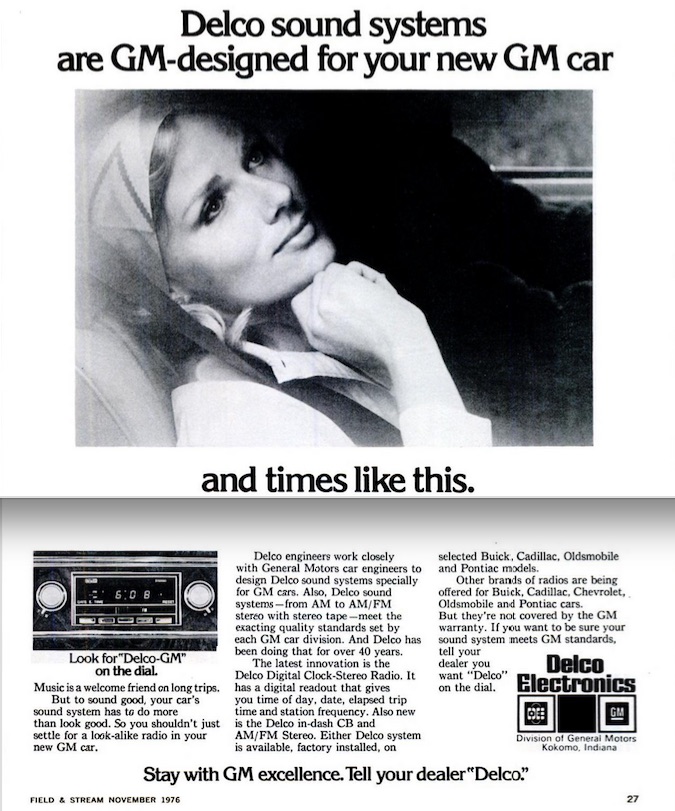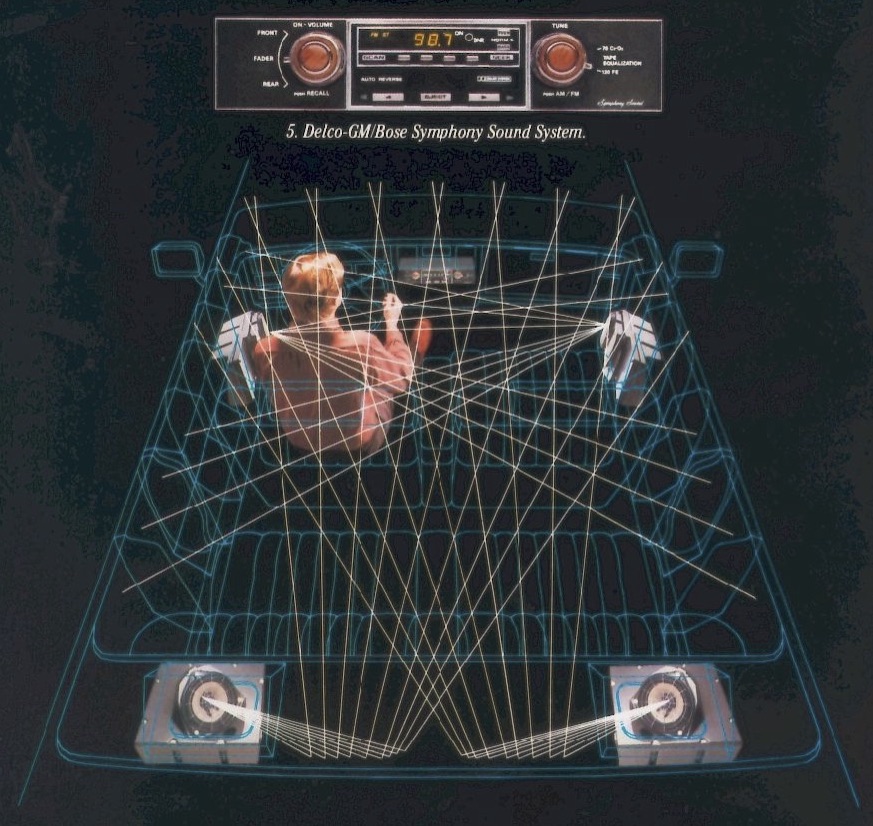|
Sound System Options Eldorado 1979-1985
Power Antenna Rebuilding, Bose Conversion & the Delco Radio Service Guide available on the Tech Info Page.
Back to the: Main Page
|
Delco's first ETR debuted in 1977, but it wasn't an ETR at all. In fact, it was a traditional, 'mechanically tuned' radio with a digital display. Now, the other top of the line radios that year adopted a new 'bridged-audio' IC in the amp section, necessitating individual + & - lines to each speaker (no more common ground). This radio was no different, but where it did differ was that it had no seek or scan function. And it goes without saying, no cassette, 8-track, or CB combo was available with it, either.
Eager to show off its digital capability, it provided time of day (as we've come to expect) but also the current date and an elapsed time feature. Available on (almost) all divisional models, few examples exist in the wild. On a Cadillac, where the base radio was already AM/FM Stereo, this option added an extra $106 ($520 in 2022 dollars). This jumped up to $364 if ordered on an Olds 98, which had a lower model 'base' radio. Click Here for Tech Info on the UP2.
|
|
For 1978, a true ETR was offered with an integral 8-track player (though the tape door doesn't say the usual “Stereo Eight”, perhaps to deter theft). This radio was a Fleetwood & Seville exclusive, though the GM full-line brochure suggests 'select Buick' model(s) as well.
Triple-concentric controls allowed for local/distant and band selection with small rings around the volume and tuner knobs, in addition to balance and fade. If you wanted a CB or Cassette offering, you'd have to wait. The '77 digital-display radio was also still available, though gained a chrome band switch to dress things up (3rd radio down).
|
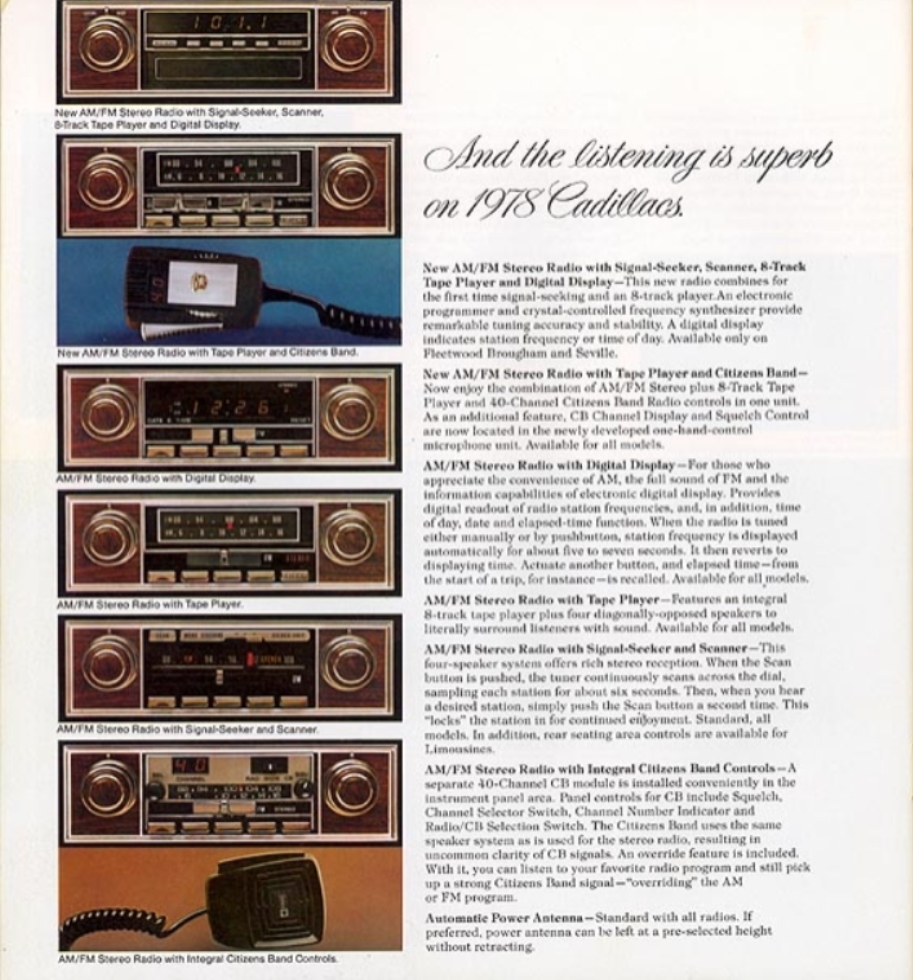 |
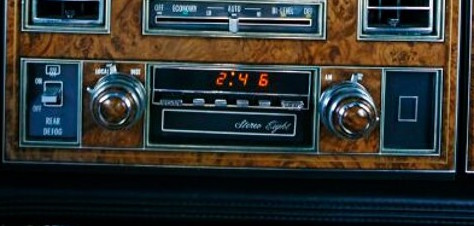 |
Now come the '79 models. All Cadillac offerings are ETR's. You had your choice of a base AM/FM stereo, AM/FM + Cassette, AM/FM + 8 Track (UM4 $195), or the top-of-the-line AM/FM/8-Track/40-Channel CB radio (UM5 a >$500 option on non-Cad models...and more than 10% of the base price of a Cutlass Supreme)
The CB transceiver was a seperate box mounted behind the glovebox and was NOT made by Delco. In addition, two different (and incompatible) units were sourced. Cads equipped with a CB are easy to spot with their load coil mounted half-way up the antenna mast, and not all CB masts are the same, either, as improvements reduced coil size.
Also of note, those triple-concentric controls were carried over from '78, but were dropped for '80, making it a 2-year only design, 1-year only for Eldo.
|
|
1980: There are now 6 different radio options. AM/FM, AM/FM/Cassette, AM/FM/8T, AM/FM/8T/CB or a new AM/FM/Cassette/CB unit. Wow!
Generally speaking, a lot of these radios look like '79 carry-overs, but factory information suggests there were a number of improvements year-over-year, even for the equivalent model. Not just features, but sound quality improvements, too. For example, 1980 ETRs now tune down to 87.7 MHz on FM and have less background noise due to circuit improvements (reduced signal path, different IC's).
Note the loss of the Local/Distant control....supposedly integrated into the Seek/Scan buttons.
|

1980 AM/FM/8T/CB |
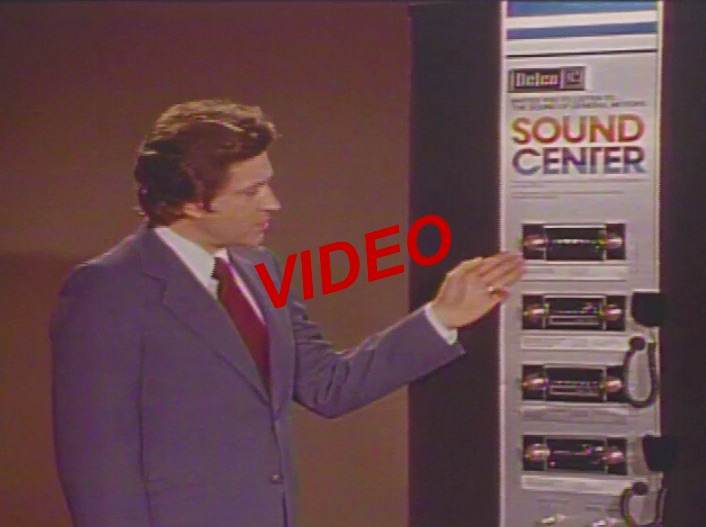
1981 Delco Radio Offerings |
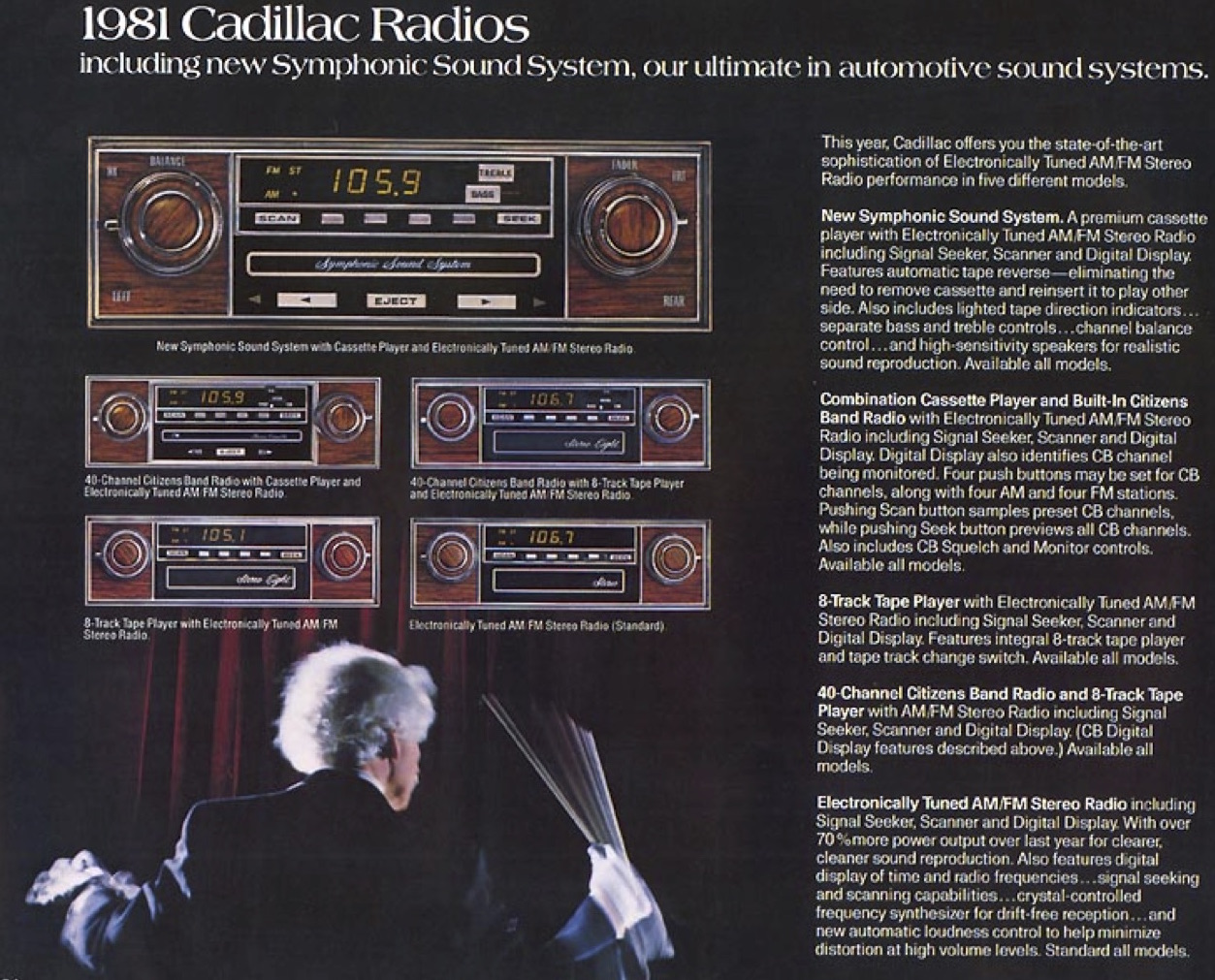 |
1981: The standard lineup is similar to '80, but the AM/FM/CB option is dropped in favor of a premium cassette unit that offers auto-reverse. Previously you had to physically flip the tape over. The CB is still available with cassette or 8T models.
While the new auto-reverse resembles similar Delco radios we're all familiar with, note there is a lack of a DNR switch next to Treble & Base, as well as differences in the shape of the slider knobs. The text on the cassette door is also unique. (Click image to enlarge)
|
|
1982: No major developments for model-year '82. The base cassette is dropped, and the auto-reverse “Symphony Sound” version becomes the default for cassette if you don't add CB. [Option UM6 $290]
A new slim-line power antenna is introduced for both the CB and non-CB models. See the Tech Section for information on antenna removal and repair.
|
|
1983: The Eldorado is still using a dual-shaft radio, but the CB w/8-Track option is dropped. In its place is some big news, a new UU8 Bose option (sticker $895).
Exclusive to the E/K-bodies, and later expanded to Corvette, the system is accoustically tuned to the interior of each model (Riv, Toro, Eldo & Seville). No EQ or balance controls are provided as the frequency response is dynamic. Amplified speakers replace those in the rear parcel shelf and are added to the front doors (no depth in the dash for a sealed chamber).
Note, this '83 radio doesn't actually say Bose anywhere on it, in fact, it looks a lot like the division-shared top of the line cassette unit. Though final stage amps are in the speakers themselves.
Scroll down for more on Bose.....
|

Non-Bose Offerings for '83 |
|
1984/85: The Eldo gets a dashboard update with the new Delco 2000 receiver. 8-track is gone, but you can still get a CB (believe it or not), though the 40 channel display moves to the mic. (Left Pic)
Bose [UU8 – still $895] is again offered in this new form factor, though is incompatible with the CB option. (Right Pic)
A base AM/FM stereo or Symphony Sound cassette unit [UU6 - $299] rounds out the choices.
A note on Cadillac 2000-Series Radios: The amber LED Fuel Data and Climate Control displays were exclusive to Cad from '80 on, so when the dual-shaft radios were made obsolete in other divisions, they adopted the new green vac flourescent displays. Cadillac was the only one to stick with amber through MY85. Also, some '85 models have a yellow power button; initially I thought these were replacement radios, but the sample size is large enough that I suspect they were introduced as a running-change.
|
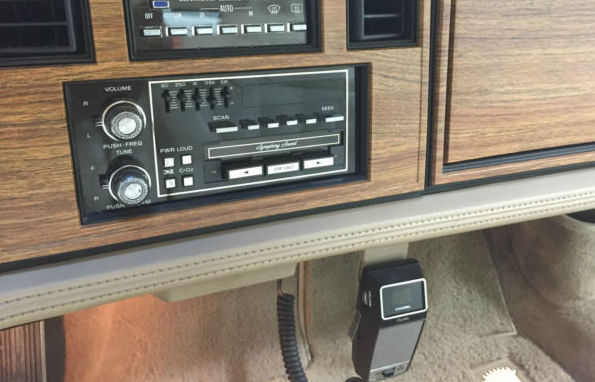
40-Channel CB with AM/FM/Cassette |
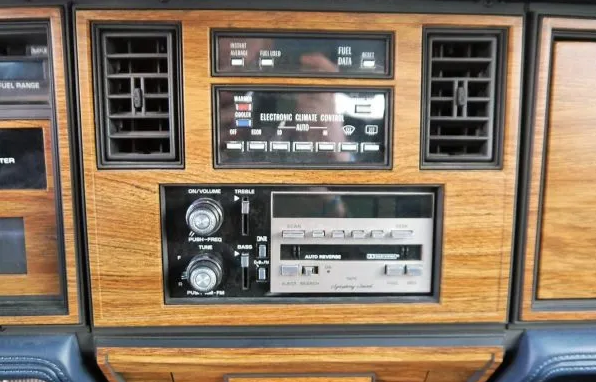
1984/85 Bose Unit - Still Labeled as Symphony Sound, unlike Corvette |
|
|
No Highs? No Lows? It must be...Bose!
I kid, I kid. (Mostly.) One issue I have with the Bose setup is that anyone sitting up front tends to block the door speakers with their legs. That kind of kills the acoustics. And since there's no balance control, it makes it impossible to compensate. Personally, I like the Symphony Sound deck with its 5-band EQ, and internal amplifier. The Seville also has an edge over the Eldo here, with rear factory 6x9's and tuned, ported enclosures; standard without Bose.
But this was a pretty big deal back in '83, and a sizable gamble by both GM and Bose. Press was quite favorable as this 1982 article from the NY Times confirms.
The modern day gripe against Bose is that the electrolytic caps degrade and the amps fail in interesting ways. Of course, now the standard radios are starting to suffer that fate. The Bose amps can be repaired/rebuilt, and I did it before for an Allanté I had some years ago. But in my old Bose-equipped ETC, I actually converted to the conventional setup. For more on that, CLICK HERE.
While I've never done it myself, it's purported on the Cad Forums that one can install '91+ 50W amp boards in the '83-85 enclosures which doubles power as well as increases frequency response.
|
|
Speakers
|
There's some speculation that GM's original speakers were actually made by Pioneer, and the Made-In-Japan stamps lend some credence.
The Eldo & Seville both use 4x6 speakers in the front (actually, all Cads of that era did). But there's a catch...the dash depth prevents most (all?) aftermarket speakers from fitting. This is especially a problem on the driver-side where magnet depth would interfere with the corner of the speedometer housing. However, there is a solution: GM 16197665. This speaker is used on new Chevy vans and appears to be physically identical to the originals, right down to the various stamped holes. The only gotcha, is the connector is a new style. If you have a soldering iron, you can detach the cone leads and using a pliers, pull the connector right off the speaker frame. Slide your old connector on, re-solder, and you're golden. Check eBay; the price is quite reasonable. In an A-to-B comparison test against a nice factory original, I couldn't tell the difference. If you have money to burn, 15173233 from Summit Racing looks like another option, having the correct connector. But does it sound better than 16197665?
|
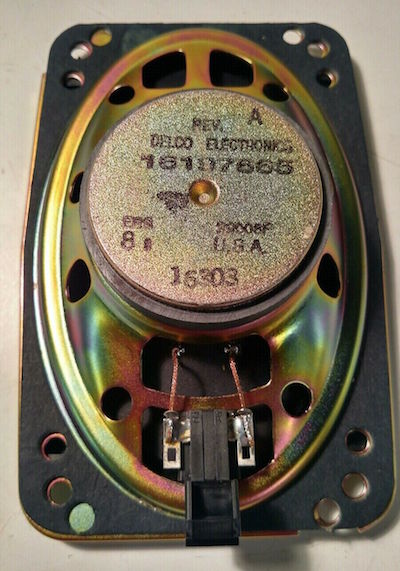
|

Stock speakers: (L) Seville 6x9 Rear (R) E/K Front |
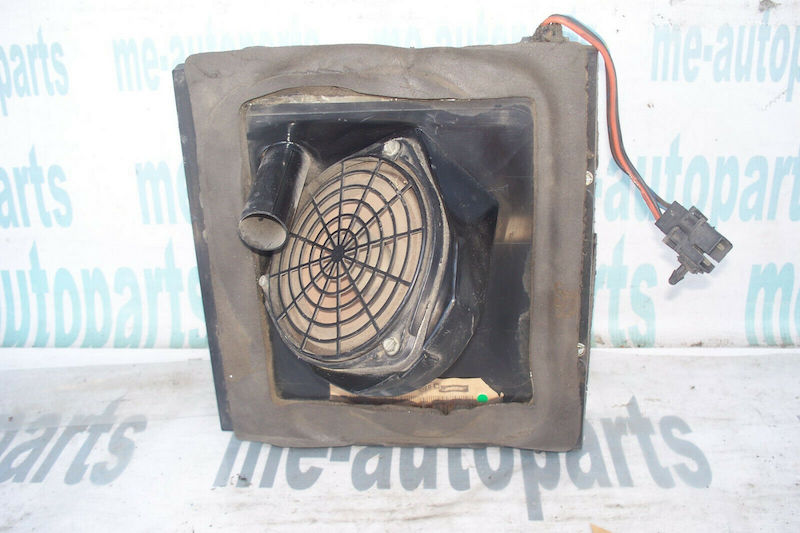
Seville Bose w/integrated amp.
Eldo is half the width, twice as long. |

Seville Non-Bose, fairly massive sealed-port enclosure. |
|
Eldorado rear speakers are also a challenge; the narrow package shelf dictates 4x10's, whereas the Seville has the more readily-available 6x9 size (that come out from below). On the Eldo, the speakers are attached to the shelf itself, and come out from above. Removing the shelf can be a little tricky. Early cars show velcro securing the center, and a notched shelf such that it bends along a crease in the center. The 85's I've messed with always have had a screw in the center, and no such crease. About the best advice I can offer is to slide the shelf to one extreme and carefully lift at the center, guiding the opposite side out so it doesn't snag the sail panel. The '83 shop manual advises removing the rear seat back but that made little difference on my '85.
The good news is that a variety of quality 4x10 speakers are now on the market. I was quite satisfied with Pioneer TS-A4103's which have a surprising amount of bass response for such a form factor. The new (but Chinese) speakers the previous owner had installed in my '85 pale in comparison. Don't forget to install the hard rubber "cups" into the shelf area first; these isolate the speakers and also provide 'a lift' to the parcel shelf to keep it even along the rear window.
Additional Speaker p/n info:
Front:
79 All Cad: 16006240 unless you have UP8: 7895010
80-83 All Cad: 16006240
83-85 All Cad: 16023012
Rear:
79 E,K: 16003571
80-81 E:16003571
82-83 E: 16014300
83 E w/CB: 16014320
84 E w/U66: 16014300, 16014320
85 Assume ’84 Carry-Over
For Bose-to-Standard Radio Conversion, Click Here.
|
|
|
More on the 1977 Digital UP2 A5 radio....For the Techies
So we've already established these radios had the new isolated bridge-amplifier IC's (no common ground), and were still mechanically tuned, with mechanical presets, like their predecessors. So how did the digital display work?
Like most digital readouts, the 7-segment displays were muxed. In this case, a 10kHz oscillator (IC3), which also provided the timebase for elapsed time, and time of day, provided the mux switching. If set to AM, an IC counter (IC1) was coupled to the local oscillator and acted like a frequency counter. When changed to FM, given the high 'MHz' frequency, the sampling was divided by 100 (two divide-by-10 stages). A deviation of 10 Mhz by the L.O. (indicating tuning was in progress) would trip the display to switch over to show the frequency. After 5 seconds, the display switched back over to the clock. A Darlington-array drove the individual segments.
Given the additional circuitry, and the fact that the signal-seekers relied on a bulky motorized tuner, the engineers must have decided foregoing Seek & Scan for digital dazzle was a worthwhile trade-off.
Click Here for a great overview,
courtesy of Electronic Technician/Dealer Magazine, 1977. |
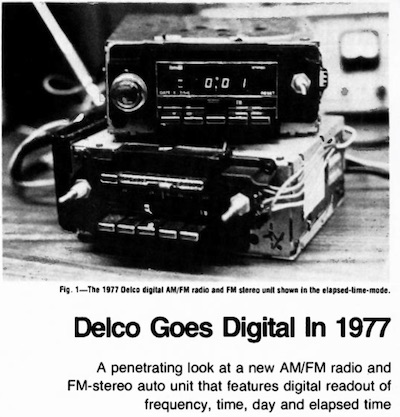 |
|
|
Return to Main Page Comments? Corrections? Contact Webmaster Cory Heisterkamp 2022
|
